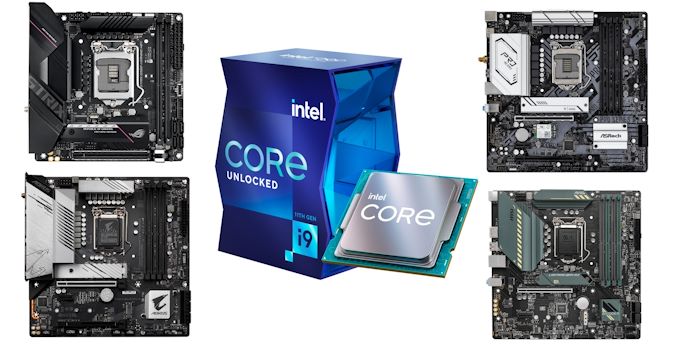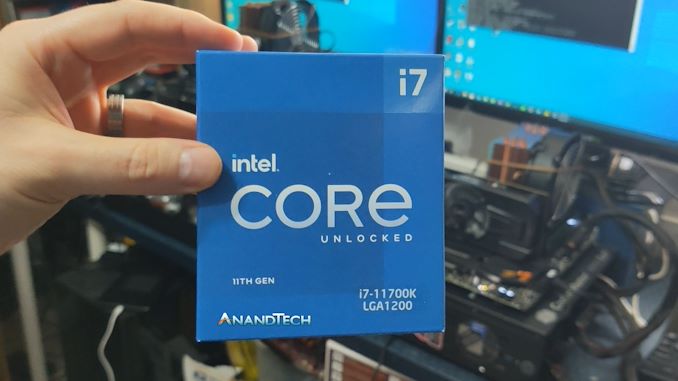Intel Rocket Lake (14nm) Review: Core i9-11900K, Core i7-11700K, and Core i5-11600K
by Dr. Ian Cutress on March 30, 2021 10:03 AM EST- Posted in
- CPUs
- Intel
- LGA1200
- 11th Gen
- Rocket Lake
- Z590
- B560
- Core i9-11900K
Conclusion
For anyone buying a new system today, the market is a little bleak. Anyone wanting a new GPU has to actively pay attention to stock levels, or drive to a local store for when a delivery arrives. The casual buyers then either look to pre-built systems (which are also flying off the shelves), or just hang on to what they have for another year.
But there is another way. I find that users fall in to two camps.
The first camp is the ‘upgrade everything at once’ attitude. These users sell their old systems and buy, mostly, all anew. Depending on budget and savings, this is probably a good/average system, and it means you get a good run of what’s available at that time. It’s a multi-year upgrade cycle where you might get something good for that generation, and hopefully everything is balanced.
The other camp is the ‘upgrade one piece at a time’. This means that if it’s time to upgrade a storage drive, or a memory kit, or a GPU, or a CPU, you get the best you can afford at that time. So you might end up with an older CPU but a top end GPU, good storage, good power supply, and then next time around, it’s all about CPU and motherboard upgrades. This attitude has the potential for more bottlenecks, but it means you often get the best of a generation, and each piece holds its resale value more.
In a time where we have limited GPUs available, I can very much see users going all out on the CPU/memory side of the equation, perhaps spending a bit extra on the CPU, while they wait for the graphics market to come back into play. After all, who really wants to pay $1300 for an RTX 3070 right now?
Performance and Analysis
In our Core i7-11700K review, our conclusions there are very much broadly applicable here. Intel’s Rocket Lake as a backported processor design has worked, but has critical issues with efficiency and peak power draw. Compared to the previous generation, clock-for-clock performance gains for math workloads are 16-22% or 6-18% for other workloads, however the loss of two cores really does restrict how much of a halo product it can be in light of what AMD is offering.
Rocket Lake makes good in offering PCIe 4.0, and enabling new features like Gear ratios for the memory controller, as well as pushing for more support for 2.5 gigabit Ethernet, however it becomes a tough sell. At the time we reviewed the Core i7-11700K, we didn’t know the pricing, and it was looking like AMD’s stock levels were pretty bad, subsequently making Intel the default choice. Since then, Intel's pricing hasn't turned out too bad for its performance compared to AMD (except for the Core i9), however AMD’s stock is a lot more bountiful.
For anyone looking at the financials for Intel, the new processor is 25% bigger than before, but not being sold for as big a margin as you might expect. In some discussions in the industry, it looks like retailers are getting roughly 20%/80% stock for Core i9 to Core i7, indicating that Intel is going to be very focused on that Core i7 market around $400-$450. In that space, AMD and Intel both have well-performing products, however AMD gets an overall small lead and is much more efficient.
However, with the GPU market being so terrible, users could jump an extra $100 and get 50% more AMD cores. When AMD is in stock, Intel’s Rocket Lake is more about the platform than the processor. If I said that that the Rocket Lake LGA1200 platform had no upgrade potential, for users buying in today, an obvious response might be that neither does AM4, and you’d be correct. However, for any user buying a Core i7-11700K on an LGA1200 today, compared to a Ryzen 7 5800X customer on AM4, the latter still has the opportunity to go to 16 cores if needed. Rocket Lake comes across with a lot of dead-ends in that regard, especially as the next generation is meant to be on a new socket, and with supposedly new memory.
Rocket Lake: Failed Experiment, or Good Attempt?
For Intel, Rocket Lake is a dual purpose design. On the one hand, it provides Intel with something to put into its desktop processor roadmap while the manufacturing side of the business is still getting sorted. On the other hand it gives Intel a good marker in the sand for what it means to backport a processor.
Rocket Lake, in the context of backporting, has been a ‘good attempt’ – good enough to at least launch into the market. It does offer performance gains in several key areas, and does bring AVX-512 to the consumer market, albeit at the expense of power. However in a lot of use cases that people are enabling today, which aren’t AVX-512 enabled, there’s more performance to be had with older processors, or the competition. Rocket Lake also gets you PCIe 4.0, however users might feel that is a small add-in when AMD has PCIe 4.0, lower power, and better general performance for the same price.
Intel’s future is going to be full of processor cores built for multiple process nodes. What makes Rocket Lake different is that when the core was designed for 10nm, it was solely designed for 10nm, and no thought was ever given to a 14nm version. The results in this review show that this sort of backporting doesn’t really work, not to the same level of die size, performance, and profit margin needed to move forward. It was a laudable experiment, but in the future, Intel will need to co-design with multiple process nodes in mind.












279 Comments
View All Comments
GeoffreyA - Tuesday, March 30, 2021 - link
It could be due to x264 limiting the number of threads because when vertical resolution divided by threads drops below a certain threshold---I think round about 30 or 40---quality begins to suffer.GeoffreyA - Wednesday, March 31, 2021 - link
I tested this now on FFmpeg but it should be the same on Handbrake because the x264/5 libraries are doing the actual encoding.I only have a 4C/4T CPU but used the "-threads" switch to request more. On x264, regardless of resolution, once more than 16 threads are asked for, it logs a warning that it's not recommended but goes ahead and uses the requested count, up to 128. I assume that running at default settings, like AT is probably doing with Handbrake, will let x264 cut off at 16 by itself. If someone could confirm this with a 32-thread CPU, that would be nice. As for x265, I gave it a try as well and the encoder refuses to go on if more than 16 threads are requested, saying the range must be between 0 and X265_MAX_FRAME_THREADS.
In short, I reckon both these codecs are cutting off at 16 threads on default settings. If Ian or someone else could test how much extra is gained by manually putting in the count on a 32T CPU, that would be interesting.
scott_htpc - Tuesday, March 30, 2021 - link
Splat. Backporting doesn't really work & dead-end platform.What I'd really like to read is a detailed narrative of Intel's blunders over the last 5-10 years. To me, it probably makes a case study in failed leadership & hubris, but I would really like to read an authoritative, detailed account. I'm curious why the risks of their decisions were not enough to dissuade them to take a better path forward.
Prosthetic Head - Tuesday, March 30, 2021 - link
Yes, some sort of post mortem on Intel development over the last few years would be interesting. Once they abandoned the Pentium 4 madness, they did a good job with Core, Core2 and then the early stages of the 'i' series. Because AMD were by that point down their own dead end, they had essentially no competition for about a decade. The tempting easy explanation is that as a de facto monopoly for desktop and laptop CPUs, they only innovated enough to keep the upgrade cycle ticking over, then when AMD made a rapid comeback they got caught with their pants down and some genuine technical difficulties in fab tech.... But the reality could be a lot more complex and interesting than that.Hifihedgehog - Tuesday, March 30, 2021 - link
> But the reality could be a lot more complex and interesting than that.The reality is Conroe was a once-in-a-lifetime IPC improvement, literally 90% better (or nearly double the performance!) clock-for-clock than the ill-fated Pentium 4 (see here: https://www.reddit.com/r/intel/comments/m7ocxj/pen... They are not going to get that again unless Gelsinger clones himself across Intel's entire leadership team. Now, they may get something Zen-like in the ~50% range, but nothing Conroe-like unless ALL the stars align after a decade of complacency.
Hifihedgehog - Tuesday, March 30, 2021 - link
https://www.reddit.com/r/intel/comments/m7ocxj/pen...29a - Tuesday, March 30, 2021 - link
Keep in mind that P4 was a piece of shit built for marketing high clock speeds and was easily beaten by Athlon 64 running 1Ghz slower so getting that much IPC wasn't as hard as usual.GeoffreyA - Wednesday, March 31, 2021 - link
"Keep in mind that P4 was a piece of"Not to defend the P4, but Northwood wasn't half bad in the Athlon XP's time, beating it quite a lot. It was Prescott that mucked it all up.
TheinsanegamerN - Wednesday, March 31, 2021 - link
TBF, the only reason it wasnt half bad is AMD's willingness to just abandon XP. I mean, only 2.23 GHz? 3 GHz OCs were not hard to do with their mobile lineup, and those obliterated anything intel would have until conroe. IF they had released 2.4, 2.6, and 2.8 GHz athlon XPs intel would have been losing every benchmark against them.GeoffreyA - Friday, April 2, 2021 - link
Oh yes, the XP had the higher IPC and would have given Intel a sound drubbing if its clocks were only higher. Thankfully, the Athlon 64 came and turned the tables round. I remember in those days my heart was set on the 3200+ Barton but I ended up with a K8 budget system of sorts.